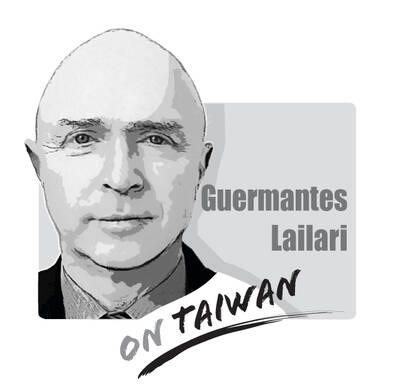The Chinese government has once again demonstrated that it is not sincere about “putting politics aside” in cross-strait exchanges. Politics might be its priority, even for the entertainment business.
Last week, Taiwanese director and actor Leon Dai (戴立忍) — who was to play the lead role in the Chinese movie No Other Love (沒有別的愛), directed by Chinese director and actress Zhao Wei (趙薇) — was accused of being pro-Taiwanese independence because of his participation in social movements in Taiwan.
At first, Dai said that he has never been a supporter of Taiwanese independence, with the movie’s production team backing him.
However, due to overwhelming public pressure, the production team and investors had Dai replaced, forcing him to issue a statement detailing his family background, explaining why he has taken part in social movements and declaring that he has always considered himself Chinese.
However, the Chinese audience did not believe Dai and even started attacking his girlfriend, Taiwanese actress Gwei Lun-mei (桂綸鎂), as the girlfriend of a pro-Taiwanese independence actor.
This is not an isolated incident.
Earlier this year, Chou Tzu-yu (周子瑜), a Taiwanese member of South Korean pop group TWICE, was accused of sympathizing with the Taiwanese independence movement and was forced to apologize on camera for waving a Republic of China (ROC) flag on a South Korean TV show.
Taiwanese pop diva A-mei (阿妹) was banned from China for several years for singing the ROC national anthem at former president Chen Shui-bian’s (陳水扁) inauguration ceremony in 2000.
The witch hunt is not limited to Taiwanese entertainers.
On Friday, Japan-based model/actress Kiko Mizuhara was forced to apologize on camera because she “liked” a photograph on Instagram of Chinese dissident artist Ai Weiwei (艾未未) making an inappropriate gesture at Tiananmen Square — a national symbol of China.
Zhao herself has also fallen victim to extreme nationalism in China.
In 2002, she became a target of public criticism — and even physical assault — when she was photographed wearing a dress with a Japanese rising-sun symbol on it.
Zhao was accused of sympathizing with Japanese imperialism and was forced to apologize under threat from numerous TV stations to boycott her.
Has China not been saying, “let politics be politics and let entertainment be entertainment,” and that China and Taiwan should put aside political differences while enhancing cross-strait exchanges?
Has China not been pressuring President Tsai Ing-wen (蔡英文) to recognize the so-called “1992 consensus,” a supposed understanding between the Chinese Nationalist Party (KMT) and the Chinese government that both sides of the Strait acknowledge there is “one China,” with each side having its own interpretation of what “China” means?
If China was sincere about what it has been saying, no entertainers would have been subjected to a political witch hunt, especially when the social movements that Dai took part in did not even involve Taiwanese independence.
If China is sincere about the “1992 consensus,” then Taiwanese entertainers should not be boycotted for singing the ROC national anthem or waving the ROC flag in public, as the ROC is just a different interpretation of “one China.”
The examples show that China is never sincere about what it says and its so-called “concessions” are just sugar-coated poison pills that no one should take seriously.

Chinese state-owned companies COSCO Shipping Corporation and China Merchants have a 30 percent stake in Kaohsiung Port’s Kao Ming Container Terminal (Terminal No. 6) and COSCO leases Berths 65 and 66. It is extremely dangerous to allow Chinese companies or state-owned companies to operate critical infrastructure. Deterrence theorists are familiar with the concepts of deterrence “by punishment” and “by denial.” Deterrence by punishment threatens an aggressor with prohibitive costs (like retaliation or sanctions) that outweigh the benefits of their action, while deterrence by denial aims to make an attack so difficult that it becomes pointless. Elbridge Colby, currently serving as the Under
The Ministry of the Interior on Thursday last week said it ordered Internet service providers to block access to Chinese social media platform Xiaohongshu (小紅書, also known as RedNote in English) for a year, citing security risks and more than 1,700 alleged fraud cases on the platform since last year. The order took effect immediately, abruptly affecting more than 3 million users in Taiwan, and sparked discussions among politicians, online influencers and the public. The platform is often described as China’s version of Instagram or Pinterest, combining visual social media with e-commerce, and its users are predominantly young urban women,
Most Hong Kongers ignored the elections for its Legislative Council (LegCo) in 2021 and did so once again on Sunday. Unlike in 2021, moderate democrats who pledged their allegiance to Beijing were absent from the ballots this year. The electoral system overhaul is apparent revenge by Beijing for the democracy movement. On Sunday, the Hong Kong “patriots-only” election of the LegCo had a record-low turnout in the five geographical constituencies, with only 1.3 million people casting their ballots on the only seats that most Hong Kongers are eligible to vote for. Blank and invalid votes were up 50 percent from the previous
Japanese Prime Minister Sanae Takaichi lit a fuse the moment she declared that trouble for Taiwan means trouble for Japan. Beijing roared, Tokyo braced and like a plot twist nobody expected that early in the story, US President Donald Trump suddenly picked up the phone to talk to her. For a man who normally prefers to keep Asia guessing, the move itself was striking. What followed was even more intriguing. No one outside the room knows the exact phrasing, the tone or the diplomatic eyebrow raises exchanged, but the broad takeaway circulating among people familiar with the call was this: Trump did